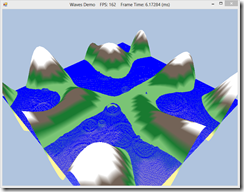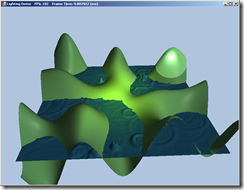First off, we are going to modify our previous Waves Demo to render using per-pixel lighting, as opposed to the flat color we used previously. Even without any more advanced techniques, this gives us a much prettier visual.


[font=Arial]
To get there, we are going to have to do a lot of legwork to implement this more realistic lighting model. We will need to implement three different varieties of lights, a material class, and a much more advanced shader effect. Along the way, we will run into a couple interesting and slightly aggravating differences between the way one would do things in C++ and native DirectX and how we need to implement the same ideas in C# with SlimDX. I would suggest that you follow along with my code from
[/font]https://github.com/ericrrichards/dx11.git[font=Arial]. You will want to examine the Examples/LightingDemo and Core projects from the solution.
[/font][font=Arial]